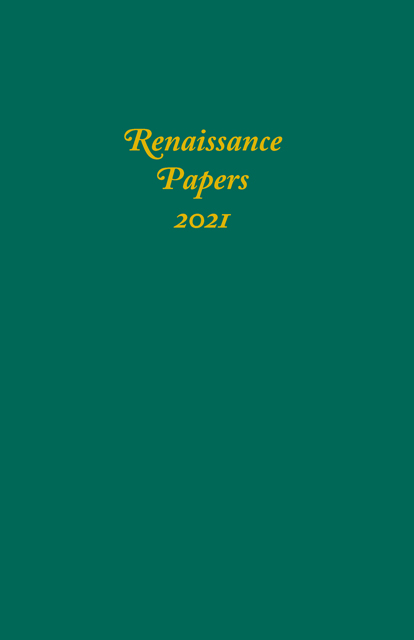Book contents
- Frontmatter
- Contents
- Dedication
- “Strange Serious Wantoning”: Early Modern Chess Manuals and the Ethics of Virtuous Subterfuge
- “Both Use and Art”: Motifs and Method in Astrophil and Stella
- Embodied Love(rs): Injury and Comedy in Mary Wroth’s Urania
- Edmund Spenser’s Automaton Alchemy: The Case of False Florimell
- Who Edited the 1571 Mirror for Magistrates?
- Statues Living and Conscious: Hermetic Statue-Magic in The Winter’s Tale
- Transmutation and Refinement: The Metaphysics of Conversion and Alchemy in Renaissance Spain
- The Twelve Inka and the Twelve Caesars: Reflections on an Early Modern Visual Theme in the Art of Colonial Peru
- Linguistics and Epistemology in Thomas Harriot’s North Atlantic World
- Assembling the King’s Body: Examining Holbein’s Portrait Techniques and the Fashioning of Henry VIII’s Image in the English Renaissance
- Molière’s L’École des Femmes between Shame and Guilt
The Twelve Inka and the Twelve Caesars: Reflections on an Early Modern Visual Theme in the Art of Colonial Peru
Published online by Cambridge University Press: 17 December 2022
- Frontmatter
- Contents
- Dedication
- “Strange Serious Wantoning”: Early Modern Chess Manuals and the Ethics of Virtuous Subterfuge
- “Both Use and Art”: Motifs and Method in Astrophil and Stella
- Embodied Love(rs): Injury and Comedy in Mary Wroth’s Urania
- Edmund Spenser’s Automaton Alchemy: The Case of False Florimell
- Who Edited the 1571 Mirror for Magistrates?
- Statues Living and Conscious: Hermetic Statue-Magic in The Winter’s Tale
- Transmutation and Refinement: The Metaphysics of Conversion and Alchemy in Renaissance Spain
- The Twelve Inka and the Twelve Caesars: Reflections on an Early Modern Visual Theme in the Art of Colonial Peru
- Linguistics and Epistemology in Thomas Harriot’s North Atlantic World
- Assembling the King’s Body: Examining Holbein’s Portrait Techniques and the Fashioning of Henry VIII’s Image in the English Renaissance
- Molière’s L’École des Femmes between Shame and Guilt
Summary
On January 14, 1572, thirty-seven prominent descendants of the Inka gathered in Cusco, the former capital of the pre-Columbian empire. A few months prior, the new Viceroy of Peru, Francisco de Toledo, had arrived in the city, part of a yearslong inspection of the territories. Shortly after arriving, Toledo commissioned a series of four painted cloths, or paños, on which were depicted the figures of the Inka rulers, their wives, along with descriptions of notable events of their reigns and legends of their origins. In March, the paintings were sent to Spain as a gift for King Philip II. The descendants of the Inka gathered on that day in January were there to voice their approval of the paños, confirming the truth of the representation.
While the paintings do not survive, and were possibly destroyed in a fire at Madrid’s Alcázar Palace in 1734, it is probable that traces of them remain in the depictions of the Inka that encircle the frontispiece of the “Fifth Decade” of Antonio de Herrera’s Historia general de los hechos de los castellanos, published in 1615 (see fig. 1). Diana Fane has observed that the arrangement of the Inka therein, placed in medallions and ordered chronologically from the founder of the dynasty, Manco Capac, to Huascar, identified as the last, mirror the arrangement of the Caesars depicted on a frontispiece of a 1591 publication of Torrentius’s Commentary on Suetonius’s Lives of the Twelve Caesars (see fig. 2). Suetonius’s tome, originally penned in the second century, contained biographical sketches of the first twelve emperors of Rome, or Caesars, and was among the most popular antiquarian texts of the early modern period. Although this comparison may seem offhand, it is in fact possible, even probable, that the paños were intentionally modeled after early modern depictions of the twelve Caesars; at the very least, they circulated in a context where such connections would have shaped their reception. Indeed, acknowledging this connection enriches our understanding of how the paños operated pictorially within Toledo’s overall project to promote the legitimacy of Spain’s occupation of Peru.
Toledo’s Paños in the Documentary Record
There are obvious obstacles to discussing paintings that no longer exist and of which no detailed copies were made. Herrera’s engraving, although modeled after the paños, no doubt takes some liberties, most obviously by including a thirteenth Inka, who did not appear among those paños commissioned by Toledo.
- Type
- Chapter
- Information
- Renaissance Papers 2021 , pp. 87 - 106Publisher: Boydell & BrewerPrint publication year: 2022

